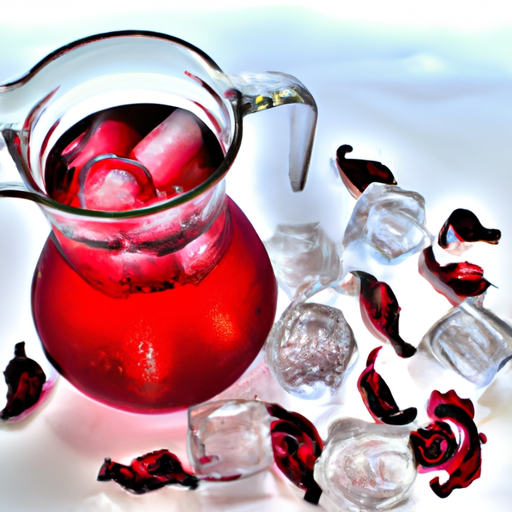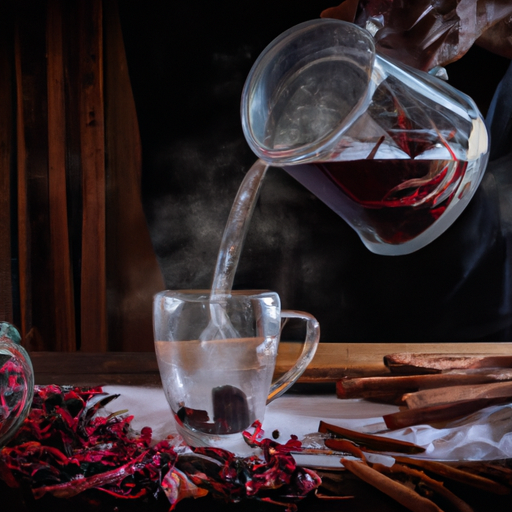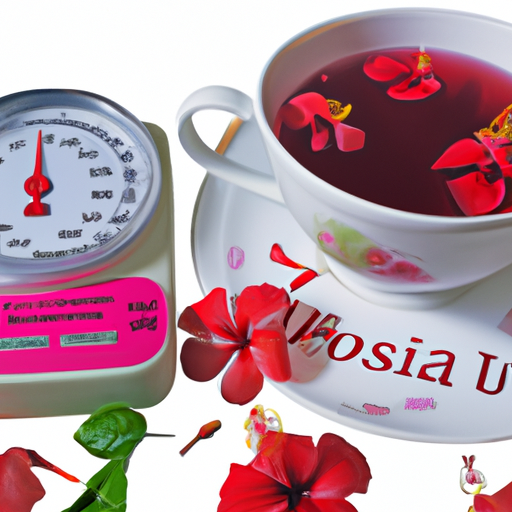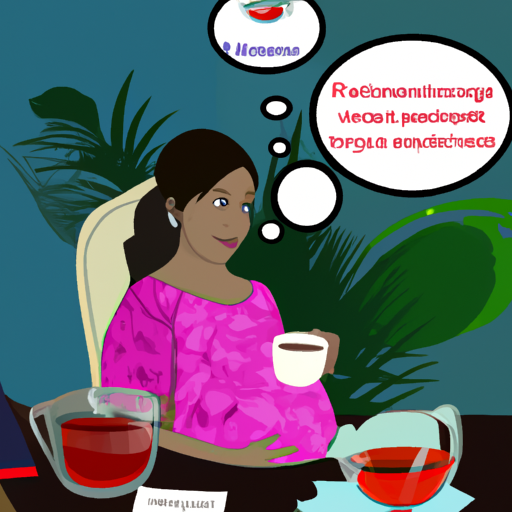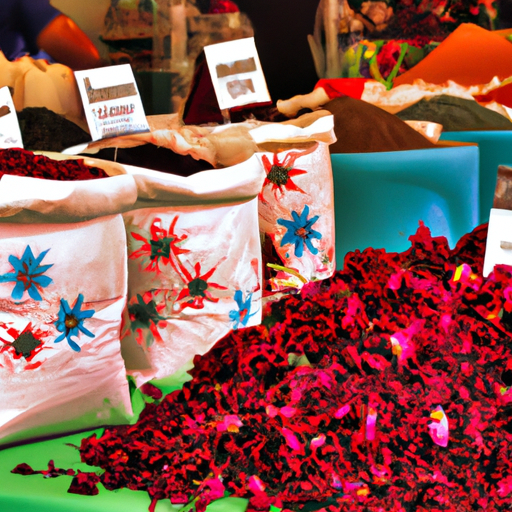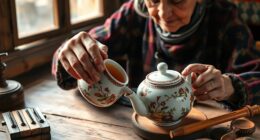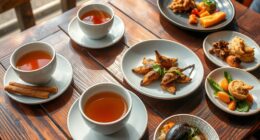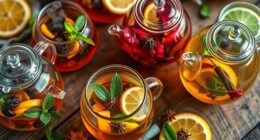I’m totally enamored with hibiscus tea! It offers a delightful and revitalizing method to reap the health advantages of this stunning bloom.
But did you know that making your own hibiscus tea from flowers is easy and affordable? In this article, I’m going to share with you my favorite method for brewing hibiscus tea at home.
First, let me tell you a little bit about hibiscus flowers. They’re not just pretty to look at – they’re also packed with antioxidants and other nutrients that can help promote heart health, lower blood pressure, and even aid in weight loss.
Plus, they have a tangy, slightly tart flavor that makes them perfect for brewing into a flavorful tea.
So if you’re ready to learn how to make your own hibiscus tea from flowers, keep reading!
Key Takeaways
- Hibiscus tea is a refreshing and affordable way to enjoy the health benefits of hibiscus flowers, which are rich in antioxidants and nutrients for heart health, lower blood pressure, and weight loss.
- To make hibiscus tea, boil water and steep fresh or dried flowers for 5-15 minutes, and strain the liquid through a fine mesh strainer for a smooth texture. Adding honey, sugar, lemon juice, or mint can enhance the taste.
- Hibiscus plants are easy to grow and maintain, and thrive in warm climates with plenty of sunlight and well-draining soil. They offer numerous health benefits and nutritional value, and their flowers can be used for cooking and making natural dyes.
- Incorporating hibiscus tea and plants into daily routines is a wise choice for optimal health and wellbeing.
Selecting and Preparing Hibiscus Flowers
Now it’s time to get your hands on some fresh hibiscus flowers and start preparing them for your delicious tea! First, you’ll need to select the right flowers. Make sure they’re bright in color and free from blemishes or damage. You can find these at most specialty grocery stores or online.
Next, you’ll want to dry the hibiscus flowers. This is important because it helps to preserve their flavor and nutrients. To do this, simply lay the flowers out on a clean towel in a warm, dry place for several days until they become crisp and brittle.
Before brewing your tea, make sure you remove any green or brown parts of the flower as these can add bitterness to your tea.
With that said, let’s move onto boiling water and steeping the flowers!
Boiling water and steeping the flowers is an essential part of making hibiscus tea. By pouring hot water over the dried hibiscus flowers, you’ll extract all of their goodness into a delicious tea that has many health benefits such as lowering blood pressure and reducing inflammation.
So let’s get started!
Boiling Water and Steeping the Flowers
First, you’ll need to heat up some water until it’s boiling hot. For one cup of hibiscus tea, I recommend using around 8-10 ounces of water. Once your water is boiling, turn off the heat and add in your hibiscus flowers. You can use fresh or dried flowers for this step.
Now it’s time to let the flowers steep in the hot water. Depending on your preference, you can steep them anywhere from 5-15 minutes. Here are a few flavor variations and brewing techniques to consider:
- For a stronger, more tart flavor, steep the flowers for at least 10 minutes.
- If you prefer a sweeter taste, add honey or sugar while the flowers are steeping.
- To enhance the floral notes of the tea, try adding a squeeze of lemon juice or a sprig of fresh mint.
- Experiment with different brewing times and flower-to-water ratios until you find your perfect cup of hibiscus tea.
Once your desired steeping time has passed, it’s time to strain out the flower petals and serve your freshly brewed hibiscus tea!
In the next section, we’ll cover how to properly strain and serve this delicious beverage without any bits of flower floating around in it.
Straining and Serving
After steeping the hibiscus flowers in hot water for your desired amount of time, strain the liquid through a fine mesh strainer to remove any sediment or bits of plant material that may have been left behind. This step is crucial in ensuring that your hibiscus tea has a smooth texture and doesn’t taste gritty.
Pour the brewed tea into a pitcher or teapot, depending on how much you made. When it comes to serving hibiscus tea, presentation can be just as important as taste. For an added touch of elegance, garnish each glass with a slice of lemon or lime and sprig of fresh mint.
Not only will this make your drink look more visually appealing, but it’ll also enhance the flavor by adding a subtle hint of citrus and herbaceousness. Aside from its refreshing taste, hibiscus tea offers numerous health benefits such as lowering blood pressure and reducing inflammation.
By incorporating this flavorful beverage into your daily routine, you can reap these advantages while enjoying a delicious thirst-quencher. In the next section, I’ll show you how to transform this hot brew into a refreshing iced tea perfect for summertime sipping.
Making Iced Hibiscus Tea
To cool down on a hot summer day, all you need is some brewed hibiscus tea and a few ice cubes. Making iced hibiscus tea is easy and refreshing.
Once the tea is brewed and strained, simply pour it into a pitcher filled with ice. There are many variations of hibiscus tea that can be used for making iced tea.
Some people like to add lemon or lime juice for a citrusy twist, while others prefer to sweeten it with honey or agave syrup. Regardless of how you choose to flavor it, iced hibiscus tea is an excellent way to stay hydrated during the hot summer months.
Not only is iced hibiscus tea delicious, but it also has health benefits. Hibiscus flowers are rich in antioxidants and may help lower blood pressure and cholesterol levels. Drinking iced hibiscus tea regularly can also boost your immune system and improve digestion.
With all these benefits, it’s no wonder why so many people enjoy this refreshing beverage! Now that you know how to make delicious iced hibiscus tea, it’s important to store any leftovers properly.
In the next section, I’ll explain how to store leftover brewed hibiscus tea so that you can enjoy its taste and health benefits for days to come without losing its freshness or flavor.
Storing Hibiscus Tea
You can keep the refreshing taste of your iced hibiscus tea alive for days by properly preserving its vibrant color and zesty tang. To ensure that your hibiscus tea stays fresh, it’s important to choose the best containers for storage. Glass jars with airtight lids or reusable silicone bags are great options as they prevent air from entering and damaging the tea’s flavor.
When storing hibiscus tea, it’s important to note its shelf life. While freshly brewed hibiscus tea can last up to a week in the refrigerator, it may lose its potency after two days. To extend its shelf life, store it in an airtight container in the fridge or freezer. Frozen hibiscus tea cubes are perfect additions to smoothies or cocktails.
Preserving your iced hibiscus tea is key to enjoying its delicious taste over time. With proper storage techniques and quality containers, you’ll be able to relish each sip even days later.
Now that we’ve discussed how to preserve your hibiscus tea, let’s move on to exploring some exciting new recipes!
Hibiscus Tea Recipes
After learning how to store hibiscus tea, it’s time to explore some delicious recipes that will make your taste buds dance! Hibiscus tea is not just a refreshing beverage, but it also has numerous health benefits. It’s rich in antioxidants, which can help lower blood pressure and cholesterol levels. Plus, it’s naturally caffeine-free!
One of my favorite ways to enjoy hibiscus tea is by adding fresh fruit or herbs. You can mix in some sliced strawberries or raspberries for a fruity twist. Or try adding some mint leaves for a refreshing kick. Another great flavor combination is hibiscus and ginger. Just add a slice of fresh ginger root while brewing the tea and enjoy the zesty flavor.
If you’re feeling adventurous, you can even add some spices like cinnamon or clove to create a warm and cozy drink perfect for chilly nights. The options are endless when it comes to creating unique flavors with hibiscus tea.
Now that we’ve explored some tantalizing recipes, let’s move on to other uses for hibiscus flowers beyond just making tea.
Other Uses for Hibiscus Flowers
Exploring the versatility of hibiscus beyond its tea-making potential can open up a world of creative possibilities for your culinary and skincare adventures.
Hibiscus flowers are not just pretty to look at, but they also have practical uses in various fields. Here are some ideas on how to use hibiscus flowers beyond making tea:
-
Hibiscus flower crafts: Dried hibiscus flowers can be used for crafting projects such as making potpourri sachets, wreaths, and pressed flower art. The vibrant colors of the petals make for beautiful decorations that can add a pop of color to any room.
-
Hibiscus flower decorations: Fresh hibiscus flowers make for stunning table centerpieces or floral arrangements. They can also be used to decorate desserts or cocktails, adding both visual appeal and a tangy flavor.
-
Skincare: Hibiscus is known for its anti-inflammatory properties and antioxidants that promote healthy skin. You can create your own face mask using hibiscus flowers by grinding them into a fine powder and mixing with honey or yogurt.
-
Culinary Uses: In addition to making tea, you can use fresh or dried hibiscus flowers in recipes such as jams, jellies, syrups, or even savory dishes like salads or stews.
-
Medicinal purposes: Ayurvedic medicine has long embraced the benefits of hibiscus in treating ailments such as high blood pressure and liver disease.
With so many versatile uses for this beautiful flower, it’s no wonder that people continue to discover new ways to incorporate it into their lives.
Growing your own hibiscus plants allows you access to an endless supply of fresh blooms that you can use in myriad ways.
Benefits of Growing Hibiscus Plants
I’ve loved using hibiscus flowers for various purposes, from cooking to making natural dyes. But one of my favorite things about these beautiful blossoms is their ability to grow into stunning plants that can be enjoyed for years.
Not only are they visually appealing, but hibiscus plants also offer a host of benefits that make them a worthwhile addition to any garden. To start with, they’re relatively easy to grow and maintain. They thrive in warm climates with plenty of sunlight and well-draining soil.
If you live in an area with colder temperatures, you can still enjoy these lovely flowers by growing them indoors or in containers on your patio or balcony. With proper care, hibiscus plants can grow up to 15 feet tall and produce vibrant blooms throughout the year.
Aside from their aesthetics, hibiscus plants are also known for their nutritional value. When consumed as tea or juice, the flowers provide a rich source of antioxidants and vitamin C which help boost the immune system and reduce inflammation in the body. Moreover, studies have shown that regular consumption of hibiscus tea may help lower blood pressure levels and improve cardiovascular health overall.
Growing hibiscus plants not only adds beauty to your surroundings but also provides numerous health benefits. By following basic growing tips such as ensuring adequate sunlight and watering regularly, anyone can cultivate these gorgeous flowers at home. And with their high nutritional value when consumed as tea or juice, there’s no doubt that incorporating this plant into your daily routine is a wise choice for optimal health.
Frequently Asked Questions
Can I use dried hibiscus flowers instead of fresh for making tea?
Using dried hibiscus flowers instead of fresh for making tea is absolutely possible! In fact, many people prefer using dried flowers as they tend to have a stronger flavor.
When it comes to health benefits, hibiscus tea has been known to lower blood pressure and cholesterol levels, help with digestion, and even aid in weight loss efforts.
Whether you choose to use fresh or dried hibiscus flowers, the benefits remain the same. So go ahead and brew yourself a cup of this deliciously refreshing drink – your body will thank you!
How long does it take to boil water for hibiscus tea?
When it comes to making hibiscus tea, the boiling time and water temperature are crucial factors that can affect the taste and quality of the final product.
In my experience, it usually takes around 5-7 minutes for water to reach boiling point on a stove. Once the water starts boiling, I turn off the heat and let it sit for a minute or two before pouring it over the hibiscus flowers in my teapot.
This allows the water temperature to cool down slightly, which prevents scorching or burning of the delicate flower petals. Additionally, I always make sure to use fresh filtered water rather than tap water, as it can contain impurities that may affect the flavor of the tea.
By following these simple steps and paying attention to details like boiling time and water temperature, you can enjoy a delicious cup of hibiscus tea that is both refreshing and soothing for your senses.
Is it necessary to strain the tea before serving?
Yes, it’s necessary to strain the tea before serving. Straining has many benefits, such as removing any loose petals or debris from the flowers that may have made their way into the tea during brewing. Additionally, it helps to create a smoother and more pleasant mouthfeel by removing any gritty or chunky bits that may be present in an unstrained tea.
When it comes to brewing techniques for hibiscus tea, there are a few things to keep in mind. First and foremost, make sure that you’re using fresh water that’s been brought up to boiling point before adding in your hibiscus flowers. Allow the mixture to steep for at least 5-7 minutes before straining and serving over ice or hot.
By following these simple steps and taking care when straining your hibiscus tea, you’ll end up with a delicious and refreshing beverage that’s perfect for any occasion.
Can I add sweeteners to hibiscus tea?
Yes, you can definitely add sweeteners to hibiscus tea! As someone who loves a little sweetness in my beverages, I’ve experimented with different natural sweeteners for my hibiscus tea.
One of the benefits of using natural sweeteners is that they offer a healthier alternative to sugar, which can lead to health issues when consumed in excess. Some great options include honey, agave nectar, and stevia.
Honey adds a delicious floral flavor that complements the hibiscus well, while agave nectar has a neutral taste and doesn’t overpower the tea’s flavor. Stevia is a zero-calorie option that provides sweetness without any added calories or sugar content.
So feel free to experiment with these alternatives to sugar for your next cup of hibiscus tea!
Are there any potential side effects of drinking hibiscus tea?
Before delving into how to make hibiscus tea from flowers, it’s important to address any potential risks associated with drinking this popular herbal beverage.
While hibiscus tea is generally considered safe for most people when consumed in moderation, some individuals may experience side effects such as upset stomach, dizziness, or headache.
It’s also worth noting that hibiscus tea can lower blood pressure and interact with certain medications, so it’s always a good idea to consult with your healthcare provider before adding this drink to your daily routine.
As for recommended dosage, experts suggest consuming no more than 2-3 cups of hibiscus tea per day to avoid any adverse effects.
By being mindful of these factors, you can enjoy the many benefits of hibiscus tea without putting your health at risk.
Conclusion
Well, there you have it, folks! A simple and easy way to make hibiscus tea from the comfort of your own home. Who would’ve thought those beautiful flowers in your garden could be turned into a delicious and healthy beverage?
It’s almost ironic, isn’t it? We often admire the beauty of nature without fully realizing its potential. But now we know better!
Next time you see those vibrant red or pink flowers blooming in your yard, don’t just appreciate them for their aesthetic value. Pick a few and brew yourself a cup of refreshing hibiscus tea instead.
Not only will you be able to enjoy its tart and tangy flavor, but you’ll also reap its numerous health benefits.
So go ahead, give it a try, and let us know how it turns out!

